To get beautiful and luxuriant hair, Victorian and Edwardian ladies followed a night-time hair routine: After brushing out tangles and massaging the scalp with oil or hair tonic, they braided their long hair to protect it at night.
‘I believe it is impossible for a woman who does not brush and braid her tresses every night to have as luxuriant locks as one who regards this routine’ (Health And Beauty Hints, 1910, p. 14).
Night-Time Hair Routine – Victorian & Edwardian Hair Care
Let The Hair Rest
‘Nearly half of your life is spent in bed and thus nearly half of your life your hair is in tight pig-tails and curl-papers. This is unfortunate for many reasons. First of all, it keeps the scalp from the air and is not good for the roots of the hair.
Secondly, it would drive the most devoted man to the other woman or the uttermost parts of the earth. Take quite as much pains in arranging your hair for the night as you would for a party. Do not attempt to put it up conventionally, but dress it picturesquely.’ (San Francisco Call, 1904)
Air The Hair
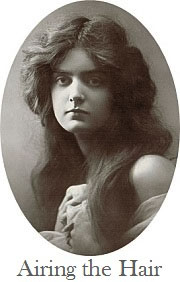 ‘More necessary, even, than washing, is airing the hair in summer’ (Health And Beauty Hints, 1910, p. 43). ‘Ventilation is as important for the hair as for the lungs. It [the hair] should be lifted from the scalp and shaken lightly every night before retiring, then braided lightly and loosely.’ (San Francisco Call, 1906)
‘More necessary, even, than washing, is airing the hair in summer’ (Health And Beauty Hints, 1910, p. 43). ‘Ventilation is as important for the hair as for the lungs. It [the hair] should be lifted from the scalp and shaken lightly every night before retiring, then braided lightly and loosely.’ (San Francisco Call, 1906)
‘Eschew the brush and let your watchword be “Ventilate.” Brushing the hair does not stimulate the scalp. It merely makes the hair smooth and glossy’ (The Saint Paul Globe, 1902). ‘Nineteen heads out of twenty, so the doctors tell us, need rest from too much combing and arranging. When hair is thin, dry, fading or falling, it needs rest.’ (Los Angeles Herald, 1903) ‘It is not well to twist the hair and pin it, however lightly, for the scalp should be relieved of any weight through the night.’ (Health And Beauty Hints, 1910, p. 18)
To twist the braided hair ‘on the head, and pin there, is to invite thinness.’ (Health And Beauty Hints, 1910, p. 43) ‘It is best […] not to confine the hair at night. Braid it losely or have it flowing if it does not snarl easily.’ (Marin Journal, 1901)
Brush Out Tangles
‘The hair should be given a five minutes’ brushing night and morning.’ (San Francisco Call, 1909) ‘I believe that it is impossible for a girl to have pretty hair, and I know that she cannot possess luxuriant tresses when an old woman, unless she brushes and combs her tresses before going to bed. To remove the pins, and twist the locks, or let them hang, is as 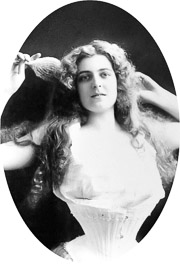 injurious as it is to cloth to lay it away without smoothing. Both must be made ready to rest if they are not to wear out quickly. […]
injurious as it is to cloth to lay it away without smoothing. Both must be made ready to rest if they are not to wear out quickly. […]
For a regular evening treatment there should be at least twenty long strokes of the brush after all snarls have been removed with a comb. The stroking should be even and firm, without causing pain. […]
Bearing in mind to have a fairly stiff brush to aid in stimulating the glands, and a coarse-tooth comb, she should first take out all tangles. To do this she must not pull, for that breaks the hair, but must work gently, always below, not above the knot. This will draw apart and smooth interwoven hairs without pulling them out. […]
Related: About Brushing The Hair – Victorian And Edwardian Hair Care
A portion of this treatment consists in combing the hair thoroughly and brushing it, not only flat to the head, but putting the brush underneath and drawing the hair loose and free, so that all parts are ventilated. Each stroke must begin on the scalp so the tips of the bristles are felt.’ (Health And Beauty Hints, 1910, p. 18ff)
‘Many women fail to understand the great benefit of the proper care of the hair before retiring. Often the hair is allowed to remain done up during the sleeping hours, and combing and brushing at such time is rarely ever done.
To acquire a beautiful growth of hair the following hygienic laws should be followed without fail: Take down the hair at night and comb out evenly and smoothly; then brush thoroughly with the proper kind of brush’ (Beauty Culture, 1911, p. 138f).
Massage The Scalp
‘The best method of stimulating the scalp is massage, which any girl may practice, instead of the old-time injunction of one hundred strokes nightly with a stiff bristle brush. Lift the hair up from the scalp, allowing the air to pass through it close to the roots, and gently massage, using the balls of the fingers; never the tips.’ (The Saint Paul Globe, 1902)
‘At night the scalp should also be massaged with the fingers, using a rotary motion, and separate strands of the hair should be briskly pulled all over the head. This is to improve the circulation and bring the blood to the surface. After this a good hair tonic should be applied with a medicine dropper directly to the scalp and rubbed in a little.’ (San Francisco Call, 1909)
‘The hair tonic is ‘poured into a saucer and applied with a soft toothbrush or tiny sponge to the scalp. […] This done, massaging should begin. It consists merely in holding the fingers firmly on different portions of the scalp and bending the knuckles so that the scalp moves but the fingers remain stationary. This is continued all over the head, the operation taking fifteen minutes or more. At the finish there should be a distinct sensation of glow in the head. With these movements the hair is not tangled, because the fingers do not rub it. A final brushing is given, and the hair loosely braided for the night.’ (Health And Beauty Hints, 1910, p. 20)
‘Scalp massage is the secret of keeping the scalp and the hair healthy. It is easily done and not a great tax either on time or patience. The hair-producing scalp is loosely attached to the underlying skull, as any one can prove with the fingers. When the scalp becomes adherent to the bones underneath, and will not move easily, then the hair will fall and the healthiness of the hair follicles will become impaired.
Therefore, one should have two ends in view: that of keeping the scalp perfectly loose and flexible upon its supporting framework, the skull; and that of promoting the flow of blood to the roots so that the hair follicles will be properly nourished and the oily glands secrete their substance to keep the hair from growing dry and brittle. In order to do this only three movements of both hands in concert are necessary.
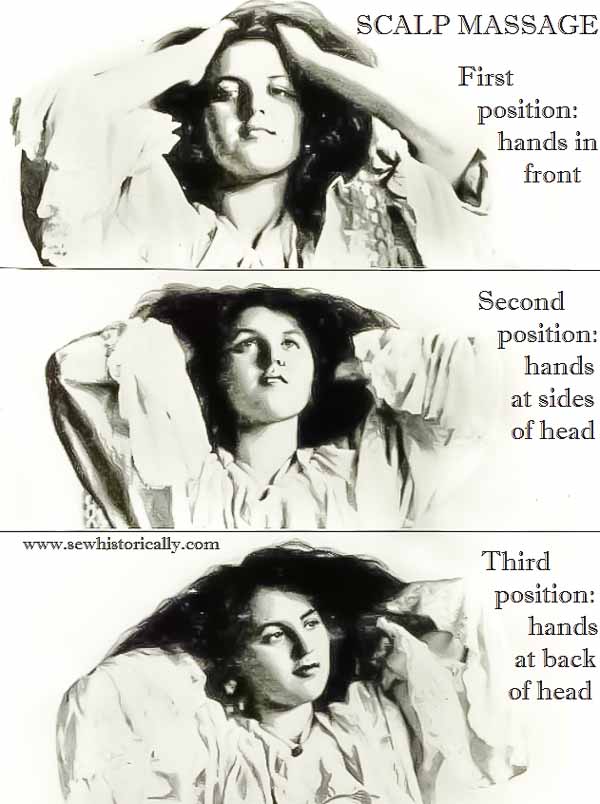
Before dressing the hair and when taking it down at night, loosen it by giving the ends of it two or three light shakes; place the tips of the fingers of both hands at the juncture of the hair and the forehead and then work them with the circular motion gently but firmly towards an imaginary centre at the top of the head.
At each turn of the fingers let them work lightly on the surface, and then deeply. The first motion is addressed to the hair follicles themselves, the next to moving the scalp on the head so as to make it soft, yielding and flexible. The second movement is made by placing the tips of the fingers so that the forefinger of each hand will meet at the spot where the last massage left off. This will bring the fingers of each hand over an ear at the juncture of the hair with the skin. In the same manner as before, they should work over the hair roots with light and deep massage until the finger-tips meet at the same centre at the top.
For the third movement of scalp massage, the fingers of each hand are placed so as to meet at the back of the neck where the hair begins, and, describing the same motions as before, they work themselves upwards to the centre.
In this manner the entire scalp in less than five minutes receives a thorough stimulation. The hair responds at once and will be found to be full of life and electricity, where before it was lifeless and dull. It will also make the whole head feel lighter and better. This manner of caring for the hair cannot be too highly recommended; it is easily and quickly done, and will keep the scalp healthy and prevent the hair from falling.’ (The Fountain Of Youth, 1905)
Oiling The Hair
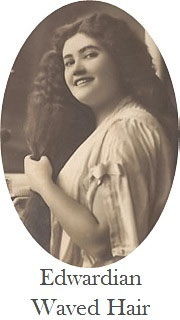 ‘When the roots of the hair are dry, either from lack of natural nourishing, excessive use of curling irons, or from the temperature, that often makes the scalp too dry, oils must be applied. […]
‘When the roots of the hair are dry, either from lack of natural nourishing, excessive use of curling irons, or from the temperature, that often makes the scalp too dry, oils must be applied. […]
Premature grayness, unless caused by illness, may almost always be traced to an absence of oils in the scalp. Therefore, when a woman too young to lose her natural color finds that her tresses are changing she should resort to applications containing stimulating oils’ (Health And Beauty Hints, 1910, p. 16ff)
Massage the roots of the hair nightly with the ‘fingers dipped in an oily tonic […] just enough to keep the tips of the fingers moistened’. (Chicago Tribune, 1903)
‘All oils made from herbs are gentle hair tonics, and those from spices have the same merit. Sweet almond oil is good, and so is castor oil, though, as a rule, each should be used in combination with some other ingredient.’ (Health And Beauty Hints, 1910, p. 17)
‘The objection that grease applied to the scalp makes the hair heavy is obviated by a knowledge of how to rub it on. Before putting any oil on the roots all tangles must be removed and the tresses divided into two parts. Into this line the grease is rubbed, a little at a time, using the finger tips. Then another clear line, close to the first, is made, and the operation repeated, until the whole scalp has been covered. Done in this way, the hair is not greasy, and the scalp is nourished.
Except in cases where the hair is noticeable dry, every other day is sufficiently often to make such an application.’ (Health And Beauty Hints, 1910, p. 17)
Braid The Hair
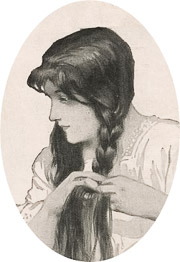 At night, ‘allow [the hair] to remain flowing, or do up in one or two loose braids according to the amount of hair.’ (Beauty Culture, 1911, p. 139) ‘One of the prettiest night arrangements is the Marguerite fashion of two plaits down the back, loosely woven and gracefully parted.’ (San Francisco Call, 1904)
At night, ‘allow [the hair] to remain flowing, or do up in one or two loose braids according to the amount of hair.’ (Beauty Culture, 1911, p. 139) ‘One of the prettiest night arrangements is the Marguerite fashion of two plaits down the back, loosely woven and gracefully parted.’ (San Francisco Call, 1904)
‘A woman whose tresses are thick should never fail to do them in two braids at night. […] One braid is better than that, but the scalp gets no refreshment even then; but by making two braids ventilation may be secured.’
Part your hair down the middle, ‘from forehead to the nape of the neck, and each half then brought over the ear, in order to leave the middle of the head free. The braids should be loose.’ (Health And Beauty Hints, 1910, p. 43) Secure the braids with silk ribbons. ‘I never use either elastic or thread to fasten the ends of the hair, for I think it breaks the hairs, making the ends uneven.’ (My Secrets Of Beauty, 1914, p. 124)
Nighttime Hairstyle With Silk Bows
‘Taking off the pompadour at night is one of the ordeals of a woman’s life. She is changed by the removal of the hair. Her full round head to a small one. No wonder that my patrons ask me what can be done when they take off their hair at night. […] I advise the Du Barry method of doing the hair at night. Puff it slightly and tie it at each temple with a big, soft pink bow. This is immensely becoming.
Just as effective is the tall black bow on top of the head. The hair is loosely drawn up from each ear to the front of the head, just over the forehead. Here a tall bow is tied and the ends lie loosely on the hair. College girls tie a tall black butterfly bow over the forehead so as to keep the hair from trailing on the face.’ (The Chicago Sunday Tribune, 1908)
Protect The Hair With Silk Caps
‘Some women wear a cap at night, but it must be of silk. A silk handkerchief, knotted at the four corners, is sometimes the most convenient arrangement. The silk, these devotees of the nightcap say, creates gloss or polish by communicating electricity to the hair.’ (Los Angeles Herald, 1903)
Perfume The Hair With Scent Caps
To perfume the hair and keep it tangle free, wear a scent cap at night. ‘Scent caps ‘cover the hair, and have the added virtue of protectiong it so that it neither snarls nor tumbles during the process. This makes combing in the morning a simpler opperation, and the hair 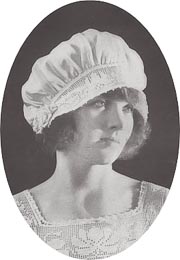 is benefited by being protected from the air.’
is benefited by being protected from the air.’
To make a scent cap, cut a circle, like a dusting cap pattern, from thin China or India silk ‘large enough to keep the hair free and allow circulation of air. It is fitted to the head by an elastic, care being taken that the latter is not too tight, or circulation will be stopped.’ Make an interlining of thin cashmere, ‘a wool material being necessary to hold the odor satisfactorily. For the lining stiff goods should not be chosen, or the head may be overheated.
Between the inner and outer cap any kind of sachet desired is sprinkled thickly’, such as orris root or any other desired scent. Orris root ‘is sweet, lasting, and never cloying. If the cap is tufted at intervals there will be less danger of the powder settling in one part.
To use the cap for best results the hair should be thoroughly brushed and combed at night and then done in a loose braid. The more every hair is exposed to the cap the more it will take the sweet odor. It is not well to make any kind of coiffure that requires pins, for the braid is simply tucked up and the cap pulled on, covering the head entirely. It is worn all night.’ (Health And Beauty Hints, 1910, p. 31f)
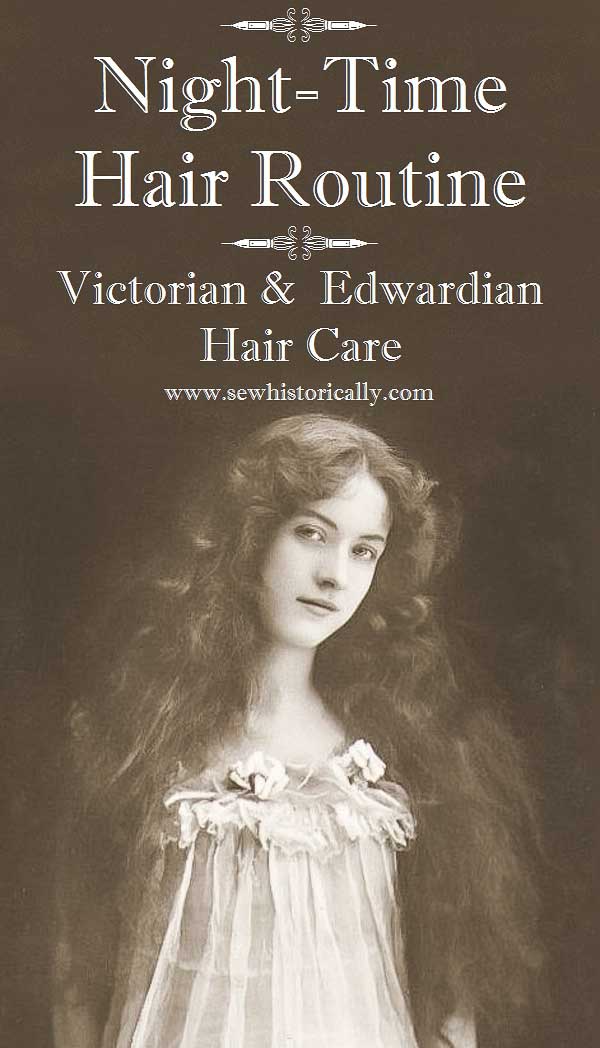
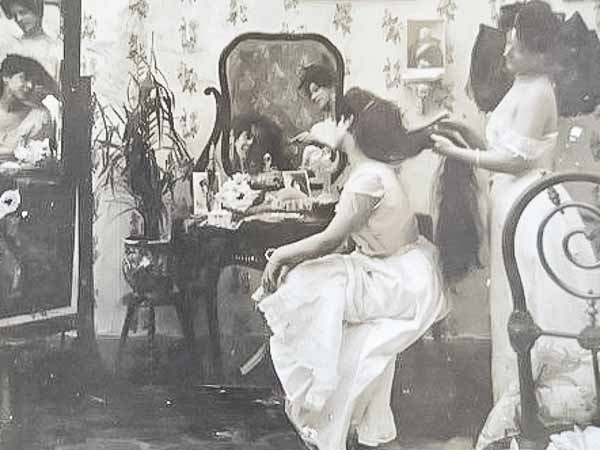
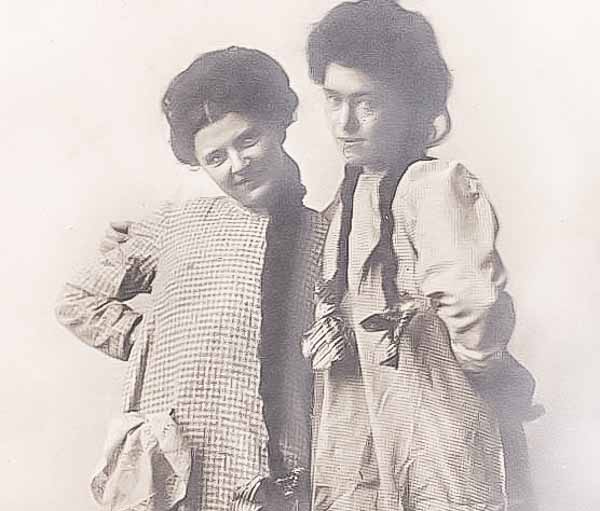
I was wondering, was there a particular care for easily frizzed hair in this time period? Constant brushing must have left some women with unruly hair. Did this phenomenon come into play? If so what was the alternative?
They didn’t wash the hair as often as we do today and they also used different shampoos: Especially egg shampoo makes the hair very soft and smooth (I tried it)! 😀 They also used bandoline – the historical version of hairspray – and invisible hair nets to keep unruly hair in place.
do you know how many times per week/month?( does not have to be exact haha) 💓
The hair was washed between thrice a week and once a month. Here you can read more about it: How Often To Wash The Hair – Victorian And Edwardian Hair Care 🙂